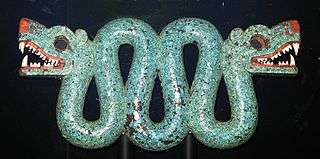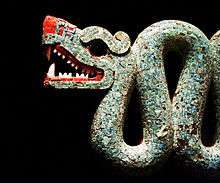Double-headed serpent
| Double-headed serpent | |
|---|---|
 | |
| Material | Wood, turquoise, pine resin, shell, and others |
| Size | 20.5 by 43.3 cm |
| Created | 15th/16th century |
| Place | Made in Mexico |
| Present location | Room 27, British Museum, London |
The Double-headed serpent is an Aztec sculpture kept at the British Museum. Composed of mostly turquoise pieces applied to a wood base, it is one of nine mosaics of similar material in the British Museum; there are thought to be about 25 such pieces from that period in the whole of Europe.[1] It came from Aztec Mexico and might have been worn or displayed in religious ceremonies.[2] It is possible that this sculpture may be one of the gifts given by the Aztec emperor, Moctezuma II, to Spanish conquistador Hernán Cortés when he invaded in 1519.[2] The mosaic is made of pieces of turquoise, spiny oyster shell and conch shell.[3]
Description

The sculpture is of an undulating serpent with heads of each side. A single block of cedar wood (Cedrela odorata)[4] forms the sculpture's base. The back side has been hollowed out, possibly to make the sculpture lighter. The back, once gilded, is not plain, and only the heads have decorations on both sides. The outer body of the two-headed snake is covered in a mosaic of turquoise, accented by red spiny oyster. Turquoise stones were broken in small, flat tesserae and adhered to the wooden body with pine resin. By using 2,000[5] small pieces, the flat pieces of stone give the impression of a faceted, curvilinear surface. The turquoise was cut and ground using stone tools.[6] Some of the turquoise was imported to Mesoamerica from approximately 1,600 km to the northwest, from the Four Corners Region of Oasisamerica where the Ancestral Pueblo people mined the stone.[5]
The heads of the serpents have holes for eyes, and remaining traces of beeswax and resin may have once held objects representing eyes, possibly orbs of iron pyrite (Fool's Gold). The vivid contrast of the red and white details on the head have been made from oyster shell and conch shell respectively.[7] Cleverly, the adhesive used to attach the Spondylus princeps[4] shell has been colored with red iron oxide (hematite) to complete the design. The white shell used for the teeth comes from shells of the edible queen conch.[3][7]
Provenance
It is not known how this sculpture left Mexico, but it is considered possible that it was among the goods given to the conquistador Hernán Cortés when he was sent to take the interior of Mico for the Spanish crown. Cortés arrived on the coast of what is now Mexico in 1519, and after battles he entered the capital on November 8, 1519 and was met with respect, if not favour, by the Aztec ruler Montezuma II. Some sources report that Montezuma thought that Cortés was the feathered serpent god Quetzalcoatl and treated him accordingly.[8] Cortés was given a number of valuable gifts, which included turquoise sculptures, and possibly this serpent. Despite the gifts and the peaceful reception, Montezuma was taken prisoner by Cortés and his troops took the Montezuma's capital, Tenochtitlan, by 1521. The Aztecs were brutally and systematically enslaved and murdered, in spite of their generosity. They then fell victim to smallpox and other European diseases brought to Mexico by Cortés and his troops.[2]
The Cortés antiquities arrived in Europe in the 1520s and caused great interest; however, it is said that other turquoise mosaics ended their days in jewellers' shops in Florence where they were dismantled to make more contemporary objects. Neil Macgregor credits Henry Christy with gathering similar artifacts into the British Museum.[9]
The sculpture is now in the possession of the British Museum and was purchased by the Christy Fund.
Significance
This sculpture is one of nine Mexican turquoise mosaics in the British Museum. There are considered to be only 25 Mexican turquoise mosaics in Europe from this period.[1]
Many theories suggest the symbolic significance of the serpent imagery. It has been proposed that the serpent was a symbol of rebirth because of its ability to shed its old skin and appear as a reborn snake. It may have been a representation of the earth and underworld with each head representing one. The snake features strongly in the gods that the people worshiped. The feathered serpent god Quetzalcoatl was important to Mixtec religion,[2] but other gods also had serpentine characteristics.
History of the World
This sculpture featured in A History of the World in 100 Objects, a series of radio programmes that started in 2010 as a collaboration between the BBC and the British Museum.
See also
References
| Wikimedia Commons has media related to Double-headed serpent. |
- 1 2 Mexican turquoise mosaics, British Museum, accessed 28 August 2010
- 1 2 3 4 Double headed serpent, A History of the World in 100 Objects, BBC. accessed 27 August 2010
- 1 2 Double-Headed Serpent, British Museum, accessed September 2010
- 1 2 "The Turquoise Mosaics". British Museum. Retrieved 28 March 2018.
- 1 2 Neil, Macgregor. "Double Headed Serpent". A History of the World in 100 Objects. BBC. Retrieved 22 September 2010.
- ↑ Question, Karl Taube, Mexicolore.co.uk, June 2006, accessed August 2010
- 1 2 Turquoise mosaics from Mexico, Colin McEwan, p.32-3, 2003, British Museum, accessed 29 August 2010
- ↑ Hernán Cortés, Latin Library, accessed August 2010
- ↑ Turquoise mosaics from Mexico, Colin McEwan, Introduction by Neil MacGregor, p.3, 2003, British Museum, accessed 28 August 2010
| Preceded by 77: Benin Bronzes |
A History of the World in 100 Objects Object 78 |
Succeeded by 79: Kakiemon elephants |